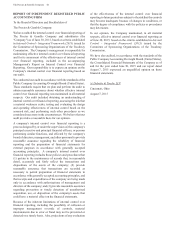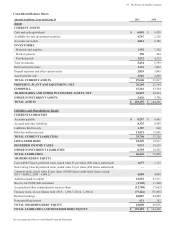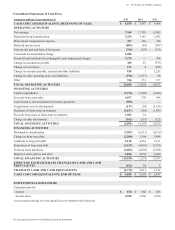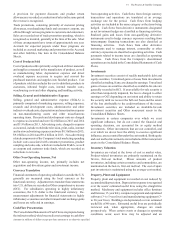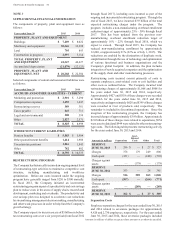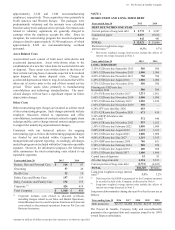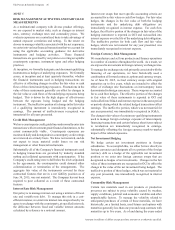Proctor and Gamble 2015 Annual Report Download - page 52
Download and view the complete annual report
Please find page 52 of the 2015 Proctor and Gamble annual report below. You can navigate through the pages in the report by either clicking on the pages listed below, or by using the keyword search tool below to find specific information within the annual report.The Procter & Gamble Company 50
Amounts in millions of dollars except per share amounts or as otherwise specified.
Notes to Consolidated Financial Statements
SUMMARY OF SIGNIFICANT ACCOUNTING
POLICIES
Nature of Oerations
The Procter & Gamble Company's (the Company, Procter
& Gamble, we or us) business is focused on providing
branded consumer packaged goods of superior quality and
value. Our products are sold in more than 180 countries and
territories primarily through retail operations including mass
merchandisers, grocery stores, membership club stores, drug
stores, department stores, salons, e-commerce, high-frequency
stores and pharmacies. e have on-the-ground operations in
approximately 70 countries.
Basis of Presentation
The Consolidated Financial Statements include the Company
and its controlled subsidiaries. Intercompany transactions are
eliminated. Prior year amounts have been reclassified to
conform with current year presentation for amounts related to
discontinued operations (see Note 13) and segment reporting
(see Note 12).
Prior to June 30, 2015, we included the results of our
enezuelan operations in our Consolidated Financial
Statements using the consolidation method of accounting. The
Companys enezuelan earnings and cash flows are reflected
in the historical Consolidated Financial Statements using a
combination of the official exchange rates, with imports of
certain essential finished goods reflected at the CENCOEX
rate of 6.30 bolivars per U.S. dollar and the remaining business,
primarily related to our on-the-ground manufacturing and
other business activities, reflected at the SICAD rate, which
generally operated in a range of approximately 12 to 13 bolivars
per U.S. dollar. Evolving conditions in enezuela, including
currency exchange regulations, other operating controls and
restrictions, reduced access to dollars through official currency
exchange markets and local market dynamics, have resulted in
an other-than-temporary lack of exchangeability between the
enezuelan bolivar and U.S. dollar, and have restricted our
enezuelan operations ability to pay dividends and satisfy
certain other obligations denominated in U.S. dollars.
hile we continue to have access to dollars through the
CENCOEX market for certain finished goods and raw
materials imports, the currency and other controls in enezuela
have significantly limited our ability to realize the benefits
from earnings of the Companys on-the-ground enezuelan
operations and to access the resulting liquidity provided by
those operations. e expect that this condition will continue
for the foreseeable future. For accounting purposes, this lack
of exchangeability and evolving conditions has resulted in a
lack of control over our enezuelan subsidiaries. Therefore,
in accordance with the applicable accounting standards for
consolidation, we deconsolidated our enezuelan subsidiaries
and began accounting for our investment in those subsidiaries
using the cost method of accounting.
This change, which we made effective June 30, 2015, resulted
in a fourth quarter fiscal 2015 one-time after-tax charge of $2.1
billion. This charge included the write-off of our investment
in our enezuelan subsidiaries, foreign currency translation
losses of $255 previously recorded in accumulated other
comprehensive income and the write-off of certain
intercompany receivables due from enezuela subsidiaries,
which was triggered by the decision to deconsolidate those
subsidiaries. Our enezuelan operationscash balance of $908
at June 30, 2015 (previously measured using a combination of
CENCOEX and SICAD exchange rates), is no longer reported
in Cash and cash equivalents.
In future periods, our financial results will only include sales
of finished goods to our enezuelan subsidiaries to the extent
we receive cash payments from those subsidiaries (expected
to be largely through the CENCOEX exchange market).
Accordingly, we will not include the results of our on-the-
ground enezuelan subsidiaries. Any dividends from our
enezuelan subsidiaries will be recorded as operating income
upon receipt of the cash.
Use of Estimates
Preparation of financial statements in conformity with
accounting principles generally accepted in the United States
of America (U.S. GAAP) requires management to make
estimates and assumptions that affect the amounts reported in
the Consolidated Financial Statements and accompanying
disclosures. These estimates are based on management's best
knowledge of current events and actions the Company may
undertake in the future. Estimates are used in accounting for,
among other items, consumer and trade promotion accruals,
restructuring reserves, pensions, post-employment benefits,
stock options, valuation of acquired intangible assets, useful
lives for depreciation and amortization of long-lived assets,
future cash flows associated with impairment testing for
goodwill, indefinite-lived intangible assets and other long-
lived assets, deferred tax assets, uncertain income tax positions
and contingencies. Actual results may ultimately differ from
estimates, although management does not generally believe
such differences would materially affect the financial
statements in any individual year. However, in regard to
ongoing impairment testing of goodwill and indefinite-lived
intangible assets, significant deterioration in future cash flow
projections or other assumptions used in estimating fair values
versus those anticipated at the time of the initial valuations,
could result in impairment charges that materially affect the
financial statements in a given year.
Reenue Recognition
Sales are recognized when revenue is realized or realizable and
has been earned. Revenue transactions represent sales of
inventory. The revenue recorded is presented net of sales and
other taxes we collect on behalf of governmental authorities.
The revenue includes shipping and handling costs, which
generally are included in the list price to the customer. Our
policy is to recognize revenue when title to the product,
ownership and risk of loss transfer to the customer, which can
be on the date of shipment or the date of receipt by the customer.






